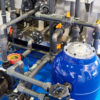Good circulation is important if you want to properly maintain your pool, and circulation directly ties to the pump operation. The more times you are able to turn over the water in your pool each day, and how many times the full pool volume passes through the circulation system will determine overall flow rate. There are three main types of pool pumps you will find on the market: Single-Speed, 2 speed Pumps and Variable Speed Pumps. The differences between single speed and 2 speed are obvious and simple. The difference in a variable speed pump is that it will allow you to adjust the flow rate of water through the system at a speed of your choosing. Usually, a single-speed pump and the High speed of a 2 speed pump correlates to the max operating speed of a variable speed pump. With a variable speed pump, you are able to circulate the water at a lower flow rate over a longer period of the day and still reduce your energy bill.
Single Speed Pumps
A single-speed pump is a traditional choice that has been in use for years by pool owners. Once you turn it on, it will continue to run at one constant speed (usually 3250 RPM’s). These are the least expensive pool pumps to buy, but they can be inefficient and noisy. A single-speed pool pump can be one of the most expensive appliances in the home and can cost up to $2,000 a year to run.
Variable Speed Pumps
Variable speed pumps use a permanent magnet motor. This is what is used in electric cars. This type of motor allows the user to pick the right flow rate they need for the pool and allows them to capitalize on the optimal pool circulation by going slower. Slower is better for circulation for 2 reasons, safety and energy conservation. Less suction reduces the chance of suction entrapment by person or animal and lower speeds also reduce the flow rate of water which creates less friction. When there is less friction, the entire system is more efficient. Variable speed pumps vibrate less, making them a quieter option. Additionally, they last longer, are cooler, and can be controlled digitally. Studies show that these pumps are over 90% more efficient than the standard one-speed pumps and only cost about $20 to $30 a month to operate.
Differences in the Two Pumps
The main difference is the speed of the pumps, but this translates to some other differences. While a single pump maintains one speed, and a variable pump can be programmed at many different speeds, in order to have efficient filtration and circulation it is better to allow the pumps to run only as needed. An average home pool should be turned over once per 24 hours. Due to the ability to change speeds, the variable pump can save you up to 90% on your annual energy costs when running the pump due to the pump affinity law. Some energy companies may even offer you rebates if you get a variable speed pump. The initial cost of the variable pump can be higher, but you will see this return on your investment in just one to two years and it will continue to save you money for years to come. Variable pumps can be integrated into an advanced pool automation system. This allows you to set timers that allow the pump to run at times during the day at different speeds and you don’t even have to think about it. You can’t do this with a single speed pump since it will only go at the same speed.

Benefits of a Variable Speed Motor
While both pumps will adequately circulate your pool, there are more advantages to getting a variable speed pump.
Energy Efficiency
The main benefit is energy efficiency. Even if the same flow rate is needed, a variable speed motor will be more efficient and use less power. This is shown with the Pump Affinity Law. The law is used to show the relationship between energy consumption, flow rates, and motor speed. It says that power consumption drops when the water flow and motor speed are decreased.
Durability
Variable speed pumps are fan-cooled and enclosed, keeping the motor cooler. This helps in preserving the motor windings and the bearings to allow these pumps to have a longer life. The enclosed design will help protect the components of the motor from the environment. Single-speed motors are induction motors with vents that can sometimes allow in water and animals causing damage.
Easy Programming and Installation
Installation of a variable speed pump is the same as a single-speed. All of the original single-speed pump components can be transferred to a variable pump except for the pump seals, which should be replaced when a new motor is installed anyway. The same wiring can also be transferred. The same lines that were used for a single-speed can also be used to supply the electricity to the variable speed. Once the motor is installed it will need to be programmed. However, since every pool is different, programming isn’t standard. The speed settings will need to get programmed according to the equipment requirements and this may require some experimenting with running at different speeds. Once the minimum speeds have been determined for the equipment the run times can be set. Water features and automatic cleaners don’t need to run the entire time you have your pump on. You may only have these items running for an hour a day. Then you can have a low RPM the rest of the day, which will give you the highest savings.
Remote Operation
Until recently, if you wanted to monitor your pool system remotely, it required an elaborate control system. Now with certain variable pumps, you have wireless capability, and once connected you are able to control the pump from any smart mobile device. This means you are able to program and adjust settings from anywhere at any time, in order to be the most energy efficient.
Quiet Operation
Since variable-speed motors are closed the noise that is made is muffled instead of being relayed through a vent. When it’s operating at a slower speed, it’s hard to tell that the motor is even running. Even when it is operating at a higher speed, it is still quieter than a single-speed pump.
Benefits of a Single Speed Motor
There are also benefits to a single-speed motor.
Upfront Cost
Single-speed motors can be cheaper than a variable speed pump, but you may want to factor in the ongoing cost of both pumps.
Reliability
Single-speed pumps have been proven to work and it’s the most reliable form of pool filtration. It can be hard to beat this history.
Contact Pool Troopers
If you are looking for a new motor for your pool, contact Pool Troopers to find the best fit for your circulation and maintenance. Our experts can help you determine what is right for your pool and help with the pool servicing you need. Contact us today!



